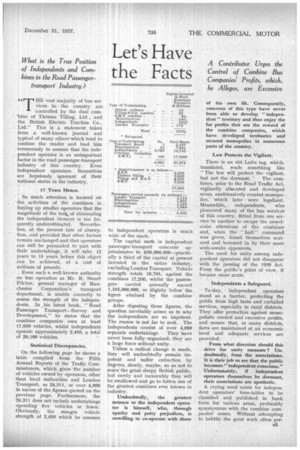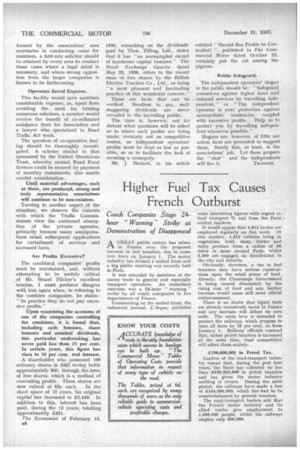Let's Have the Facts
Page 17

Page 18

If you've noticed an error in this article please click here to report it so we can fix it.
66 HE vast majority of bus ser
vices in the country are
controlled by the dual com, 'bine of Thomas Tilling, Ltd, and the British Electric Traction Co., Ltd." This is a statement taken from a well-known journal and typical of many others which tend to confuse the reader and lead him erroneously to assume that the independent operator is an unimportant factor in the road passenger-transport industry of this country. Even independent operators themselves are hopelessly ignorant of their national status in the industry.
15 Years Hence.
So much attention is focused on the activities of the combines in buying up smaller operators that the magnitude of the task of eliminating the independent element is too frequently underestimated. Nevertheless, at the present rate of absorption, and provided that other factors remain unchanged and that operators can still be persuaded to part with their undertakings, it will take 12 years to 15 years before this object can be achieved, at a cost of millions of pounds.
Even such a well-known authority on bus operation as Mr. R. Stuart Pilcher, general manager of Manchester Corporation's transport department, is unable correctly to assess the strength of the independents. In his latest book, "Road Passenger Transport—Survey and Development," he states that the combine companies own at least 17,650 vehicles, whilst independents operate approximately 2,450, a total of 20,100 vehicles.
Statistical Discrepancies.
On the following page he shows a table compiled from the Fifth Annual Reports of the Traffic Commissioners, which gives the number of vehicles owned by operators, other than local authorities and London Transport, as 24,311, or over 4,000 in excess of the figures quoted on the previous page. Furthermore, the 24,311 does not include undertakings operating five vehicles or fewer. Obviously, the meagre vehicle strength of 2,450 which he assesses
to. independent operators is much wide of the mark: The capital sunk in independent passenger-transport concerns approximates to £30,000,000—practically a third of the capital at present invested in the entire industry, excluding London Transport. Vehicle strength totals 16,795, against the combines 17,200, whilst the passengers carried annually exceed 1,165,000,000, or ,lightly below the figure attained by the combine groups.
After digesting these figures, the question inevitably arises as to why the independents are so impotent. The reason is not far to seek. The independents consist of over 4,000 separate undertakings. They have never been fully organized; they are a huge force without unity.
Unless a radical change is made, they will undoubtedly remain impotent and suffer extinction by degrees, slowly, maybe, so as not to scare the great sleepy British public, but surely and inexorably they will be swallowed and go to fatten one of the greatest combines ever known in industry.
Undoubtedly, the greatest menace to the independent operator is himself, who, through apathy and petty prejudices, is unwilling to co-operate with those of his own ilk. Consequently, concerns of this type have never been able to develop " independent " territory and thus enjoy the fat profits that are the reward of the combine companies, which have developed territories and secured monopolies in numerous parts of the country.
Law Protects the Vigilant.
There is an old Latin tag, which, translated, reads something like "The law will protect the vigilant, but not the dormant.' The combines, prior to the Road Traffic Act, vigilantly allocated and developed areas, unobtrusively created monopolies,which later • were legalized. Meanwhile, independents, who pioneered many of the bus services of this country, flitted from one service to another to escape the unwelcothe attentions of the combines and, when the " halt " command was given, found themselves scatered and hemmed in by their more wide-awake opponents.
The need for unity among independent operators did not disappear with the passing of the 1930 Act. From the public's point of view, it became more acute.
Independents a Safeguard.
To-day, independent operators stand as a barrier, protecting the public from high fares and curtailed services, especially in rural districts. They offer protection against monopolistic control and excessive profits, and ensure that, in many districts, fares are maintained at an economic level and adequate services are provided.
From what direction should this drive for unity emanate ? Undoubtedly, from the associations. It is their job to see that the public becomes" independent conscious." Unfortunately, if independent operators themselves be dormant, their associations are apathetic.
A crying need exists for indepen dent operators' time-tables to be classified and published in hook form for various areas, preferably synonymous with the combine companies' zones. Without attempting to belittle the good work often per formed by the associations area secretaries in conducting cases for members, a first-rate solicitor should be retained by every area to conduct those 'cases where a legal mind is necessary, and where strong apposition from the larger companies is known to be forthcoming.
Operators Saved Expense.
This facility would save members considerable expense, as, apart from avoiding the need for briefing numerous solicitors, a member would receive the benefit of co-ordinated assistance from his Association and a lawyer who specialized in Road Traffic Act .work.
The question of co-operative buying should be thoroughly investigated. A scheme similar to that sponsored by the United Dominions Trust, whereby annual Road Fund licences could be secured by payment of monthly instalments, also merits careful consideration.
Until material advantages, such as these, are produced, strong and truly representative associations will continue to be non-existent.
Turning to another aspect of the situation, we. observe the concern with which the Traffic Commissioners view the continued absorption of the private operator, primarily because many amalgamations entail subsequent applications for curtailment of services and increased fares.
Are Profits Excessive?
The combined companies' profits must be maintained, and, without attempting to be unduly critical of Mr. Stuart Pileher's excellent treatise, I must perforce disagree with him again when, in referring to the combine companies, he states: " In practice they do not pay excessive profits."
Upon examining the accounts of one of the companies controlling the combines, it is found that, including cash bonuses, share bonuses and nominal dividends, this particular undertaking has never paid less than 25 per cent. In certain years, this figure has risen to 50 per cent. real interest. A shareholder who possessed 100 ordinary shares in 1925 to-day holds approximately 800, through the issue of free shares, which is a method of concealing profits. These shares are now valued at 62s. each. In the short space of 12 years, his original capital has increased to 22,449. In addition to this, interest has been paid, during the 12 years, totalling approximately 2451.
The Economist of February 15, ri6 1936, remarking on the dividends paid by Thos. Tilling, Ltd., states that it has "an unexampled record of handsome capital bonuses." The Stock Exchange Gazette dated May 23, 1936, refers to the record issue of free shares by the British Electric Traction Co., Ltd., as being " a most pleasant and fascinating practice of this wonderful concern."
These are facts that can be verified. Needless to say, such staggering dividends are never revealed to the travelling public.
The time however, not far distant when questions will be asked as to where such profits are being made; certainly not on competitive routes, as independent operators' profits must be kept as low as possible, so as to facilitate the task of securing a monopoly.
Mr. J. Beckett, in his article entitled" Should Bus Profits be Controlled? ", published in The Commercial Motor dated October 22, certainly put the cat among the pigeons.
Public Safeguard. • The independent operators' slogan to the public should be : "Safeguard yourselves against higher fares and reduced' services by travelling independent," or "The independent operator is your protection against monopolistic tendencies, coupled with excessive profits. Help us to protect you by travelling independent whenever possible."
Slogans are, however, of little use unless facts are presented to support them. Surely this, at least, is the associations' job. Let them prepare the " shot " and the independents will fire it. TRANSEX.
































